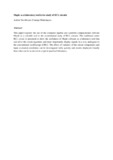Please use this identifier to cite or link to this item:
https://cris.library.msu.ac.zw//handle/11408/1752Full metadata record
| DC Field | Value | Language |
|---|---|---|
| dc.contributor.author | Nechibvute, Action | - |
| dc.contributor.author | Mudzingwa, Courage | - |
| dc.date.accessioned | 2016-08-12T07:30:46Z | - |
| dc.date.available | 2016-08-12T07:30:46Z | - |
| dc.date.issued | 2013-08 | - |
| dc.identifier.issn | 2320-7345 | - |
| dc.identifier.uri | http://ijrcar.com/Volume_1_Issue_5/V1i502.pdf | - |
| dc.identifier.uri | http://hdl.handle.net/11408/1752 | - |
| dc.description.abstract | This paper explores the use of the computer algebra and symbolic computational software Maple as a valuable tool in the experimental study of RCL circuits. The traditional series RCL circuit is presented to show the usefulness of Maple software as a laboratory tool that can solve the circuit equations and more importantly display signals in a way analogous to the conventional oscilloscope (CRO). The effect of variation of the circuit components and input excitation conditions can be investigated fairly quickly and results displayed visually than what can be achieved in a typical practical laboratory. | en_US |
| dc.language.iso | en | en_US |
| dc.relation.ispartofseries | International Journal of Research in Computer Applications and Robotics; | - |
| dc.subject | Electric circuit; RCL; Maple; laboratory; CAS; symbolic; damping; computation | en_US |
| dc.title | Maple as a laboratory tool in the study of RCL circuits | en_US |
| dc.type | Article | en_US |
| item.grantfulltext | open | - |
| item.cerifentitytype | Publications | - |
| item.openairecristype | http://purl.org/coar/resource_type/c_18cf | - |
| item.openairetype | Article | - |
| item.fulltext | With Fulltext | - |
| item.languageiso639-1 | en | - |
| Appears in Collections: | Research Papers | |
Files in This Item:
| File | Description | Size | Format | |
|---|---|---|---|---|
| Maple as a laboratory tool in the study of RCL circuits.pdf | Abstract | 4.46 kB | Adobe PDF |  View/Open |
Page view(s)
114
checked on Nov 23, 2025
Download(s)
36
checked on Nov 23, 2025
Google ScholarTM
Check
Items in MSUIR are protected by copyright, with all rights reserved, unless otherwise indicated.



